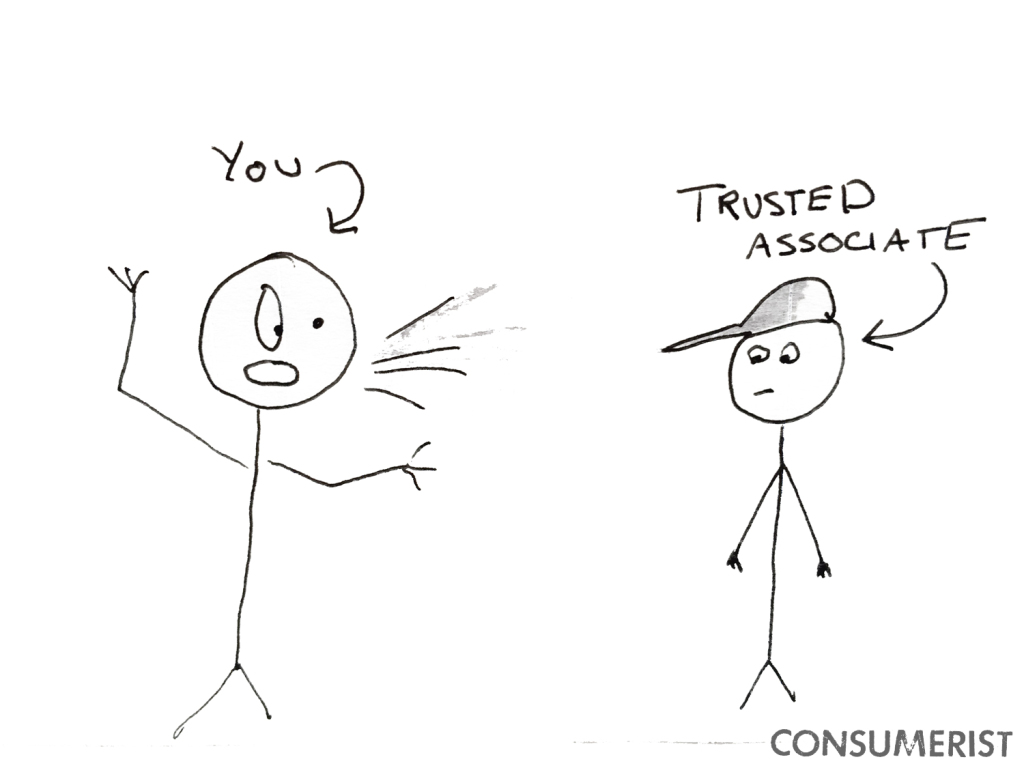The 8.5 Steps To Making An Effective Complaint That Gets A Solution Image courtesy of Great Beyond
Millions upon millions of seamless commercial transactions — interactions between consumers and business — take place every day. But sometimes, something goes wrong. Your package arrived broken. You’ve been billed for a service you cancelled three months ago. You were called something rude by an employee. Whatever it is, it’s a problem, and you need to complain about it.
Asserting your rights as a consumer is awesome, and the business that screwed up definitely needs to make it right with you. But complaining isn’t just about venting anger; there’s an art to making sure that your problem actually gets resolved in a complete and efficient manner. Before you call or write to anyone, or vent a single angry word, you need to make sure you can help that process along.
So here, in 8-ish easy steps, are the Consumerist tips for actually getting your problem solved.
Before You Call Anyone…

1.) Take A Deep Breath
Something is wrong, and it sucks. This screw-up means you are possibly out a lot of time, a lot of money, and/or something valuable. Plus, you’re disappointed that the situation didn’t work out the way you thought it would. We know: it’s awful. You’re angry! You are completely justified in being angry. Feel that feeling!
But then take some deep breaths, calm down, and work on a strategy for getting it fixed. Venting that anger on the folks you need help from will not be productive.
1a.) If Needed, Vent Safely
Are you the kind of person who just really needs to rant and scream and vent about something when it goes pear-shaped? We feel you. By all means, do that thing! Just make sure it’s either private, or to a trusted friend or partner who can handle it.
And when you figure out who that person is, make it clear you just need to vent, with lines like, “Please listen to me yell about this situation for a minute so I don’t take it out on a stranger when I actually try to get it fixed.”
And make sure it’s really, truly out of your system (or at least, as much as it can be) before you take that deep breath and move forward.
2.) Figure Out Your Actual Grievance
Odds are more than one thing went wrong. Maybe there was a snowball of events, or maybe you’re frustrated with the impact the problem has had on the rest of your life. The reality is, though: the business you are talking to cannot fix all of your personal problems. That’s not their job.
Instead, you need to zero in on the absolute core of the issue. What, specifically, went wrong? What, specifically, is broken, missing, charged wrong, or otherwise not as promised or expected?
If the issue is complicated or feels long, break it down for yourself into a bulleted list. What parts of the issue stem from an action this business took or failed to take? What should they have done differently? What happened as a result of the initial problem?
Zero in as much as you possibly can on what your specific, granular issue is. When you have a narrow, actionable complaint pared down to the basics, that’s a complaint a business can do something about. And on that note…
 3.) Figure Out What You Want Done About It
3.) Figure Out What You Want Done About It
This is a business communication, not Festivus; the airing of grievances needs to have a goal. What, specifically, do you want?
Is something missing? You need them to get you that thing. Were you double-charged? You need them to reverse that charge. Did that second charge create a cascade of fees? You want them to reimburse you for those. And so on.
If you’ve narrowed down your problem, sorting out acceptable redress follows fairly easily. X is wrong; you want the business to do Y to fix it.
Preparing this in advance lets you ask, very clearly, for what compensation you think is necessary — especially if they don’t offer it off the bat. A business simply can’t make things right for you if they don’t know, in clear and unambiguous terms, what “right” will look like.
4.) Figure Out Who To Contact
If you’re planning to go to a physical location and ask for a manager, that’s easy. Likewise, a local business will probably have an easy-to-find phone number, and most large businesses have a clearly posted customer service number.
Some companies have more than one phone number, and to minimize your chances of getting passed around like a hot potato, you’re going to want to aim for the right one to start with. If you’re a member of an airline frequent flier rewards program, for example, call that line first instead of the general line. But if your issue is with your pay-TV provider, don’t call their home security number; you’ll just be wasting everyone’s time.
If you’re trying to escalate, that gets a little trickier. We here at Consumerist are of course fans of going to executive customer service if you really need to, but successfully doing that can require you to do a little bit of sleuthing work first.
Once you’ve got your complaint and desired resolution clearly written out, and have set aside a time to make it happen, you’re ready to make that call, hop into that online chat, or march over to that store.

The Art of Complaining
Now that it’s actually time to engage, you need to put all that work you just did to good use. Any letters you write or calls you make to business (or government) need to be brief, concise, and clear, addressing those two big questions you just answered: what went wrong, and what, specifically, you want done about it.
Still at a loss for words? Here’s a sample complaint letter that worked for one Consumerist reader.
From here…
5.) Give Yourself (And Others) Some Time
If you know you have a complicated problem that’s going to need a complicated solution, don’t call customer service right before they close or plan to run over to the offending retailer during your 15-minute break from work. That’s just setting everyone up to fail.
Instead, plan for the time you need to accommodate all the steps that can be involved. If a business has a 24/7 service line, plan for calling it during off-peak hours if you can, or else be understanding that you may be on hold for a while. If a business operates during business hours, don’t settle in for something that will take an hour of their time at 5:59 p.m.
6.) Keep Track Of Everything
Whether you’re trying to get your problem resolved in person, on the phone, or online, keep a record. Use a notebook and pen, or a notes app on your phone, or a file on your computer, or an e-mail to yourself, or anything else you’ve got handy, but make sure you keep a record of details, including:
- The names of anyone you speak with
- Timestamps of when you spoke with them
- Bullet points of what was discussed
- Any specific actions they or you said would take place
- Any case, log, file, or reference number you can get them to give (and if they don’t offer, ask)
If you get any related e-mails, tag them and keep them. If you get any postal mail or hard copies of documents, record when and keep them too.
7.) Take Another Deep Breath
If you’re not getting immediate resolution, it’s okay to be frustrated and angry — but try not to lose your temper at the front-line employees who are there to help you.
8.) Follow Up
This doesn’t necessarily mean, “call, write, or show up every 24 hours.” If a company says it will take 3-4 days or 1-2 weeks to process something or get back to you, give them the time they quoted you — but be aware of when it’s running out. If those 4 business days or 2 weeks have come and gone and you haven’t gotten what they promised, it’s time to get back on the horn and escalate.
Want more consumer news? Visit our parent organization, Consumer Reports, for the latest on scams, recalls, and other consumer issues.



